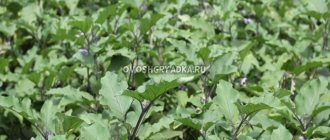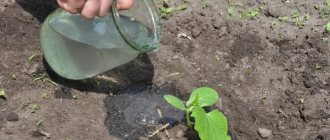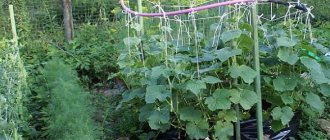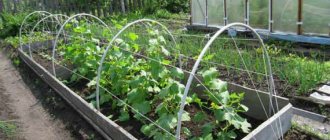- How to grow the best varieties of eggplant in a greenhouse and open ground: agricultural techniques
- Growing eggplant seedlings
- How to grow eggplants: technology for growing seedlings
- Independent preparation of seeds for sowing eggplant seedlings
- The last stage of preparing eggplant seeds for sowing: hardening
- Preparing the soil for sowing eggplant seeds
- How to grow eggplants: timing of sowing seeds
- Technology for sowing eggplant seeds for seedlings
- Temperature conditions for eggplant seedlings
- How to grow eggplants: caring for seedlings
- Watering eggplant seedlings
- Feeding eggplant seedlings
- Hardening off seedlings
- How to grow eggplants in the fall: preparing a greenhouse for growing
- Spring preparation of soil in a greenhouse for planting eggplants
- Planting eggplant seedlings in a greenhouse
- Caring for eggplants in a greenhouse
- Air temperature and humidity conditions in the greenhouse
- Watering eggplants in a greenhouse
- Feeding eggplants in a greenhouse
- Loosening the soil
- Garter and pinching of plants
- Protecting eggplants from pests and diseases in the greenhouse
How to grow the best varieties of eggplant in a greenhouse and open ground: agricultural techniques
Eggplant is always associated with the purple color and oblong fruit. But recently, breeders have offered such an abundance of varieties and hybrids, unusual in external color and structure, that it makes it difficult for the buyer to choose: round, white, striped, black, they delight and alarm. In this article we will try to understand all this diversity. In the text you will find useful information on how to grow eggplants , in a greenhouse and open ground, how to properly care for them, which varieties to choose for certain growing conditions. We will talk about all these subtleties and methods of agricultural technology for growing eggplants below.
How to grow eggplants: in a greenhouse, open ground.
Eggplants - tall, erect plants with wide, heart-shaped, dark green leaves and large, bright fruits - create a special mood in the garden beds. And in the kitchen they are a popular product for a wide variety of dishes: eggplants are fried, stewed and canned.
Of course, growing a decent harvest in the middle zone and further north is not an easy task. But subject to agrotechnical cultivation rules, it is quite accessible even to a novice gardener.
Note! To grow a large harvest, and an eggplant bush is capable of producing up to 25 fruits, you need to know some of the biological characteristics of these Indian aliens. By fulfilling the requirements for cultivation (creating familiar conditions), you will always have a high-quality harvest, regardless of the variety or hybrid growing in your garden.
Eggplant varieties for open ground
The correct choice of variety (or hybrid) is of no small importance. Store shelves are full of colorful bags, and advertising does its job: we often buy what is forced on us, but first we should take our time to read how the different varieties differ, because in winter there is enough time for this.
Varieties of many crops intended for greenhouse cultivation are not very suitable for open ground, and vice versa. Sometimes this is due to the characteristics of pollination (bees do not fly in a greenhouse), but most often it is only due to resistance to the vagaries of the weather. For planting eggplants in open ground, it is especially important to choose a variety that has good yield and a short growing season: summer in most parts of our country is short . Fortunately, there are now varieties and hybrids that meet several requirements at once:
- early ripening,
- productive,
- withstands cold weather,
- little susceptible to disease.
Early-ripening and cold-resistant eggplant varieties are suitable for growing in open ground.
The best eggplant hybrids for open ground
For capricious crops, it is more reliable to plant hybrids (indicated by the F1 icon) . True, you cannot collect seeds from them (and if collected, they will not inherit the characteristics of the mother plant), but hybrid varieties are usually more productive and most resistant to unfavorable conditions. After all, we are not chasing hybrids, for example, beets or parsley - these are unpretentious vegetables. But we increasingly use hybrid seeds when sowing cucumbers and even tomatoes. This applies even more to heat-loving eggplants. It is difficult to choose the best from many dozens of varieties (but the taste and color...), so we will give a few examples of wonderful hybrids intended for planting in open ground:
- Bull's Heart F1 - begins to bear fruit 4 months after sowing, that is, it is considered mid-early. The bush is large, branched. Requires tying: very large oval-shaped fruits grow (weighing about 300 g, sometimes up to 500 g). Their color is dark purple and shiny. Inside, the fruits are dense, almost white, without bitterness. The hybrid bears fruit for a long time, disease resistance is high;
- Galina F1 is early ripening, the bush is quite tall, spreading, the leaves are very large. The fruits are almost regular cylindrical in shape, large, reaching a length of 15 cm and weighing 200–220 g. They are painted in a dark purple color with a gloss. The pulp is loose, tender, almost white, not bitter; gourmets characterize their taste as exquisite. The total yield reaches 6.5–7 kg per 1 m2;
- Esaul F1 - medium ripening period, harvest can begin 4.5 months after sowing the seeds. The bush is of medium height and medium branching, the leaves are also of normal size. The fruits are cylindrical, thin: with a length of about 15 cm, their diameter is only 3 cm. For this reason, the maximum weight of one fruit is 200 g, and the yield is not higher than 6 kg/m2. The color is usual for eggplants, shiny. The pulp is without bitterness, greenish in color. Esaul F1 is considered one of the most delicious eggplants grown without shelter;
- Emerald F1 - characterized by a mushroom flavor and fruit aroma, the plant is very hardy: it has increased cold and disease resistance. A hybrid of medium early ripening: only 105 days pass from sowing to the state of technical ripeness of the fruit. The plant is tall, but not spreading, the leaves are large. The fruits are green, oval, up to 13 cm long, glossy. The weight of eggplant is up to 400 g, but the yield is decent: up to 7.3 kg/m2. The pulp is not bitter, almost white. It is one of the most unpretentious eggplants; fruits are formed even in cold and rainy weather;
- Lava F1 is characterized by generous and long fruiting, excellent taste and marketable properties of the fruit. Medium early ripening, spreading bush, quite tall. The fruits are cylindrical, up to 15 cm long, medium-sized: weight up to 150 g. They have a dark purple, glossy color, and the flesh is greenish-white and does not taste bitter. Productivity is good. The variety needs additional shaping or tying.
Photo gallery: popular eggplant varieties for open ground
Galina F1 - high-yielding eggplant for food lovers
Eggplant Esaul F1 - very slender
Emerald Eggplant F1 breaks the usual phrase “the color of eggplant.” Bull's Heart Eggplant F1 matches its name in appearance. Lava Eggplant F1 bears fruit for a very long time.
Tall eggplants for open ground
Gardeners try to plant tall eggplants, believing that they will get a larger harvest. There is some truth in this, although the yield is not always proportional to the size of the bush. In the greenhouse, of course, they try to save all the available space and plant bushes up to the ceiling. In the open ground, it is more convenient to care for compact bushes that do not even require tying, but for taller lovers there are also tall eggplants intended for beds without shelter . For example:
- Balagur has an extremely early ripening period, allowing you to harvest within three months after sowing the seeds. Tall bushes up to a meter tall during fruiting look like a Christmas tree with purple toys. There can be up to seven fruits on each branch; as a result, almost a hundred eggplants with a total weight of up to 8 kg are collected from just one bush: each weighs only 90–130 g, but there are so many of them... The length of the fruit is no more than 15 cm , the peel is thin, the flesh is dense, white. The taste is rated “excellent”. Balagur is famous for its increased resistance to cold and major diseases. Since this is not a hybrid, you can stock up on seeds from your harvest.
However, to get the maximum benefit from a variety, you need to work hard on it and strictly follow all the rules for growing and forming a bush. Balagur is a cluster type of eggplant, each cluster produces up to 7 fruits - Bourgeois F1 is a tall, early-ripening hybrid. The bush is tall, up to one and a half meters, requires formation, but is characterized by extraordinary resistance to disease and long-term fruiting. Due to the fact that the fruits do not ripen at the same time, many do not tie up the bushes at all, believing that they are not too overloaded. The fruits are large, purple, weighing up to 300 g, but in appearance they bear little resemblance to eggplants, more like tomatoes. The pulp is greenish-white, dense, and not bitter. The harvest is capable of long-term storage and transportation, its purpose is universal: both for preparing delicious dishes in season and for canning.
Bourgeois is an eggplant similar in shape to a tomato.
Early eggplants for open ground
Among eggplant varieties and hybrids, those that ripen 3–3.5 months after germination are considered early. There is also the concept of “super early hybrids”; their season until the technical maturity of the fruit is even shorter: up to 80 days. For the coldest regions with short summers, these are the ones that are required, and in the middle zone, early varieties can be planted. Let's look at a few examples.
- Negus is considered an extremely early variety. It grows as very low bushes (maximum 60 cm), which do not require staking and are characterized by increased cold resistance. The fruits are barrel-shaped, medium in size, weighing from 150 to 300 g, almost black in color. Since the number of fruits on the bushes is large, the overall yield is decent. The taste is considered very good. If you pick fruits at the stage of technical ripeness, fruiting continues until the onset of cold weather. If you select several fruits for seeds (and this is not a hybrid, they can be collected), they have time to ripen to readiness, but the formation of the next ones stops. Eggplants of the Negus variety are stored well and do not deteriorate during transportation; their purpose is universal.
- The Alekseevsky variety has an early ripening period - 95–105 days. The bush is undersized. The fruits are cylindrical, dark purple, 15–18 cm long, reaching a weight of 190 g. The pulp is white, without bitterness. Eggplants have good shelf life and are suitable for transportation. Can be planted in the ground in early June.
- King of the North F1 is a hybrid, it can be grown in open ground even in the Moscow region and a little further north, it is popular in Siberia. When the temperature drops, the yield does not lose. Speaking about eggplants, we usually note that 0°C is destructive for them, but this hybrid tolerates even mild frosts, and, on the contrary, does not like heat. Productivity (up to 14 kg per 1 m2) is one of the highest for early eggplants; the first fruits are ready for consumption three months after emergence. It grows as a squat bush, not reaching half a meter in height; there are no thorns. The fruits are large, very long and thin, of the usual color for most eggplants, with white flesh, not bitter.
Photo gallery: early varieties of eggplant for open ground
The extra-early eggplant variety Negus is capable of bearing fruit until cold weather
Eggplant King of the North tolerates even slight frosts
Eggplants of the Alekseevsky variety have good keeping quality
Growing eggplant seedlings
To grow a large harvest, and an eggplant bush is capable of producing up to 25 fruits, you need to know some of the biological characteristics of these Indian aliens. By fulfilling the requirements for cultivation (creating familiar conditions), you will always have a high-quality harvest, regardless of the variety or hybrid growing in your garden.
Eggplant seedlings.
The main requirement of eggplant is the length of daylight (no more than 12-14 hours). Eggplants are plants with short daylight hours, and lengthening them even by 1-2 hours leads to the fact that during the main warm period (June, July) ovaries do not form. With a decrease in day length (August, September), eggplants intensively form a harvest, but it is much smaller, since 2 main summer months are missed, when there is enough heat and other necessary conditions.
Eggplant varieties, especially old ones, are tied to day length and this feature is unchanged in old varieties. Currently, new generations of plants have been created - hybrids and varieties that are insensitive to day length. They can grow in any latitude. Therefore, before going to the market, look at the calendar, where the day length of your area is clearly indicated. Check out the varieties and hybrids of eggplant that experts recommend for your area and go purchase seeds or ready-made seedlings.
Advice from experienced gardeners
To grow a lot of large eggplants, beginners should take a closer look at the secrets of agricultural technology from those who know a lot about growing eggplants.
Helpful Tips:
- Between the beds where eggplants grow, plant plants that repel insect pests.
- Grow eggplants in warm beds. In the fall, dig a trench, fill it with waste and cover it with soil. In spring, plant seedlings on a warm nutrient substrate. This bed can be used for three years.
- The culture does not tolerate transplantation well. You should not sow seedlings in large boxes, so as not to pick them. It is better to do without picking - sow the seedlings in separate glasses.
- Eggplants need constantly moist soil, which means mulching is indispensable. Ordinary grass, straw, and sawdust can be used as mulch. Mulch will prevent the bed from drying out and reduces water costs.
For information on the rules for growing eggplants in open ground, watch the following video:
The best way to grow eggplants in open ground is from seedlings; this is the way to guarantee a harvest. For each region, you need to choose the right planting time and variety that can grow in certain weather conditions.
0
0
Copy link
How to grow eggplants: technology for growing seedlings
Seed preparation. Beginning gardeners often purchase ready-made seed material on the market or from private traders. This is the first mistake. It is unknown what quality and variety the seeds will sell you. Always purchase seed from specialized stores and centers. They have already been processed and prepared for sowing. Home-harvested seeds must be varietal; hybrids will not produce the desired yield. In this case, it is better to purchase ready-made seedlings in specialized shopping centers.
When purchasing seeds, carefully read the instructions on the bag:
- the name of the variety or hybrid, legal information about the producer (telephone, physical address, etc.) must be clearly indicated,
- when buying a hybrid, give preference to the first generation (label F1). Seeds of this generation are the most resistant to temperature conditions, diseases and pests,
- number of seeds in a bag,
- date of seed collection,
- readiness of seeds for sowing (processing).
Which eggplant varieties to choose
We have been testing eggplant varieties for a long time. We obtain seeds from the country's leading research centers and grow them in experimental fields.
We offer you the best varieties of eggplant from our collection. Hybrids F1: “Kolobok”, “Green Energy”, “Bibo”, “Bottlenose Dolphin”, “Mirval”, “Roma”, “Galine”, “Lord”, “Cavalier”, “Scamp”, “Ultra Early”, “Odyssey” ", "Topaz". Varieties: “Alekseevsky”, “Sailor”.
You can order all these varieties today from the Gardens of Russia “SEEDS 2019” catalog
If you haven’t grown eggplants on your property yet, try it next season. You will get very healthy vegetables from which you can prepare many delicious dishes and homemade preparations.
Independent preparation of seeds for sowing eggplant seedlings
Note! To awaken the seeds from biological dormancy and speed up the emergence of eggplant shoots, warm them in a thermos or hot water. At a water temperature of +45..+50 °C, immerse the seeds in a gauze bundle in hot water for 3-5 minutes (be careful not to cook them).
After heating, we pickle (disinfect) the eggplant seeds in a 1% solution of potassium permanganate to protect against diseases. Place the seeds in a gauze bag into the solution for 15-20 minutes and rinse under running water. Instead of potassium permanganate, you can treat the seeds from bacteria and fungi in a solution of one of the biofungicides phytosporin-M, alirin-B, gamair SP, trichodermin, albite according to the recommendations. In this case, the seeds are not washed, but immediately dried until they flow.
Note! Eggplant seeds germinate slowly and need sufficient nutrients in the initial stages. Therefore, they still need to be treated with growth stimulants and nutrients. To reduce the number of seed treatments, you can combine disinfection with biofungicides, growth stimulants (epin, ideal, zircon and others) and microfertilizers (microvit, cytovit) in the tank mixture.
When preparing a tank mixture, dissolve each drug separately according to the recommendations, and then pour it into one container and mix. After warming up, the seed material is immersed in the solution for 10-12 hours. Then, without washing, dry at room temperature until free-flowing.
Eggplant seedlings.
The last stage of preparing eggplant seeds for sowing: hardening
We keep the prepared dry eggplant seeds indoors during the day at a temperature of +18..+22 °C, and at night we transfer them to the bottom shelf of the refrigerator at a temperature of +2..+3 °C. We repeat this procedure for a week (5-6 days).
How to prepare seeds for sowing: useful tips and recommendations (read more)
After hardening, the seeds are almost ready for sowing. To speed up the emergence of seedlings, eggplant seeds are germinated 2-3 days before sowing. To do this, they are scattered on a damp cloth in a saucer, covered with the same damp cloth on top and placed in a warm, dark place. As soon as the seeds grow, they are transferred to a dry litter, dried and sowing begins.
Preparing the soil for sowing eggplant seeds
The soil mixture for sowing eggplant seeds must be neutral in acidity, light, air- and water-permeable, moisture-absorbing, saturated with nutrients, and disinfected from fungi, viruses, bacteria and pests.
Recommended soil mixtures:
- mature humus 2 parts,
- turf soil 1-2 parts or 1 part high-moor peat (neutral),
- 1 part sand or semi-rotten sawdust (not pine).
You can use another combination:
- 1 part humus (vermicompost) or 2 parts high-moor peat,
- 2 parts of turf or leaf soil,
- you can add 0.5-1.0 part of sand.
Note! We must disinfect the prepared mixture in the way that is most convenient for you (by heating, calcining, scalding, freezing or otherwise).
After drying the disinfected soil mixture, we revive it by mixing it with biological products “Baikal EM-1”, trichodermin, planriz and others. They promote the rapid proliferation of beneficial or effective microflora (EM drugs) and at the same time destroy microbial and fungal pathogens.
If the soil was cultivated using the wet method (with solutions), then we dry the substrate again and add fertilizers to 1 bucket of soil mixture: 30-40 g of nitrophoska and a glass of wood ash. You can add a mixture of fertilizers: 15-20 g of urea, 30-40 g of granulated superphosphate, 15-20 g of potassium sulfate or a glass of wood ash. Mix the mixture thoroughly and fill the prepared container with soil.
How to grow eggplant seedlings.
Mistakes when growing eggplants
Sometimes eggplants grow clearly poorly:
- the bush does not grow green mass, the color of the foliage is pale, with a yellowish tint;
- flowers fall;
- a small ovary appears, but then falls off;
- There are few fruits and they are small.
It is necessary to look for reasons in violation of the rules of care, soil quality, symptoms of diseases and the presence of pests. We must also remember that cold weather can cause problems. The normal temperature for eggplant development is 25–30°C. At night temperatures of 8–10°C and daytime temperatures of 14–16°C, it will not be possible to squeeze a harvest out of a chilly eggplant.
You should also avoid the following mistakes:
- planting in the shade, dense planting, more than 4–5 bushes per 1 m2. The bush is poorly lit and not ventilated, the shaded foliage turns yellow, the fruits do not turn purple, they rot, there is a high risk of fungal diseases and mold;
- uneven watering. Abundant moisture after significant drying out of the soil will lead to cracks appearing on the fruits, they will stop growing and begin to deteriorate. Watering with cold water is unacceptable;
- excess nitrogen in the soil (manure, nitrogen fertilizers). At the time of planting seedlings, this will lead to the fact that the plant will drive away the green mass (fatten) with a small harvest;
- unsuitable land. Eggplant needs loose, fertile soil; it grows poorly on heavy, dense loams and scanty sandstones.
How to grow eggplants: timing of sowing seeds
Eggplants have a long growing season and a slow rate of development. Depending on the duration of the period from germination to technical maturity, eggplants are divided into 3 groups:
- early,
- average
- late.
For early eggplants, the technical ripeness of the fruit occurs 85-90 days from germination, for middle ones 90-120 and for late ones 120-150 days.
Note! In the southern regions of Russia and other regions, eggplant seeds are sown for seedlings at the end of February - the first ten days of March. Seedlings are planted in open ground from mid-May to the first ten days of June. Depending on the timing of fruit ripening, sowing of seedlings is shifted relative to the first date by 10-12 days.
You can simultaneously sow early, middle and late varieties of eggplants for seedlings, but the timing of transfer to open ground will be different: early eggplants at the age of 45-55 days, middle 55-70 days and late 70-80 days. You can plant seedlings earlier permanently if they outgrow (stretch) and weather conditions are suitable.
In the central zone and northern regions of Russia, when planting seedlings in open ground or unheated greenhouses, under temporary shelters, eggplant seedlings are planted at the age of 60-70 days, that is, seedlings are sown on the 15th of March. Permanent planting is extended until the first ten days of June, when stable warm weather sets in. Late varieties can also be grown in these regions, but they require heated greenhouses, additional lighting and other additional conditions (which are unprofitable).
How to grow eggplants.
Features of growing eggplants in open ground in the regions
In different regions, the possibility of growing eggplants depends mainly on the number of warm summer days. Therefore, the variety and place for planting (a garden bed or a greenhouse) are chosen according to the weather.
Moscow region
In the Moscow region, climatic conditions cannot be considered optimal for eggplants: the duration of the climatic summer here does not exceed 90 days. There is also little solar radiation: up to 2/3 of the light is absorbed by clouds. The humus layer in the soil is also insufficient, although this, of course, can be corrected by additional application of organic fertilizers. Only the soils of the very south of the Moscow region are sufficiently fertile.
Among the promising varieties and hybrids for the region are the following:
- Giselle F1,
- Agate F1,
- Alyonka.
Photo gallery: the best varieties of eggplant for the Moscow region
The eggplant variety Agat F1 sets fruit well even with sudden temperature changes
Early ripening eggplant variety Alyonka is suitable for growing in risky farming areas
Giselle F1 is an early-ripening, cold-resistant, high-yielding eggplant hybrid with compact bushes
Varieties zoned for North-West Russia are also doing well. Difficulties arise when growing tall eggplants, so proper plant formation is of great importance. The warmest areas are allocated for beds, but eggplants are still initially grown under light film covers. The shelter is periodically placed on the beds in the summer, if the temperature drops below 15 ° C.
Eggplants in Siberia
Summer in many regions of Siberia, although warm, is short, so you can try to grow the earliest ripening eggplants in open ground, but first, of course, the seedlings are planted under temporary shelters. The selection of varieties must be taken very seriously; the most suitable are:
- Purple miracle
- Nutcracker,
- Robin Hood,
- Siberian early ripening.
They have time to ripen and easily tolerate temporary cold spells. There are also varieties developed directly at Siberian research institutes, for example, Globus. And although it produces only 3-4 fruits per bush, the fruits are very large and tasty.
Photo gallery: the best varieties of eggplant for Siberia
The Globus eggplant variety has unusually shaped fruits that actually look like a globe. From planting seedlings to technical ripeness of the Nutcracker F1 eggplant fruits, it takes only 45 days. Robin Hood eggplant bushes reach a height of 1 m.
The eggplant variety Violet miracle has a long period of transition from technical ripeness of the fruit to biological ripeness
The low, compact Siberian early ripening eggplant bush gives a rich harvest even in Siberian conditions
Recently, film in shelters has been replaced with acrylic materials: they are easier to handle, they allow air and moisture to pass through and regulate heat better. Without any shelter, eggplants can only be left for the two warmest months.
Video: Siberian eggplant harvest
Ukraine
Almost throughout the entire territory of Ukraine, growing eggplants does not cause problems. Only the very north of the country is somewhat similar in climate to the Moscow region, and even then it is a little warmer there. In Ukraine, most varieties and hybrids of eggplant grow well in open ground.
In the southern regions, special attention has to be paid to irrigation; when solving this problem, the yields are obtained as high as possible. In addition, the plants are fed every 2–3 weeks, each time increasing the dose of fertilizer. In the southernmost regions, it is possible to grow eggplants without seedlings, by directly sowing the seeds in the garden in mid-April. In the north of the country there is not always enough light and warmth, so they are limited to early ripening varieties.
Suitable eggplant varieties for Ukraine:
- Epic F1,
- Albatross,
- Globular.
Photo gallery: the best varieties of eggplant for Ukraine
The Epic F1 eggplant variety is famous for its high yields. The Albatross eggplant variety reaches technical ripeness in 110–116 days.
The spherical eggplant variety is mid-season, fruit weight reaches 700 g
Sowing seeds into the ground is unacceptable here, and seedlings are planted on ridges with added biofuel (manure, grass, straw). In some cases, light shelters are used temporarily.
Belarus
The Belarusian climate is very similar to that of the Moscow region, although somewhat milder. It is impossible to grow late varieties of eggplant here without a greenhouse, and the crop cannot be kept in open ground for more than 100 days. Eggplants are planted as seedlings, the seeds for growing which are sown at home or in a greenhouse at the very beginning of spring. Popular varieties:
- Baikal F1,
- Black handsome man
- Swan.
Photo gallery: the best varieties of eggplant for Belarus
The pulp of the Baikal F1 eggplant fruit is dense, light green in color, without bitterness. The Lebediny variety eggplant really resembles a beautiful white swan in color. A short bush of eggplant, the handsome black one, bears fruit on the 115–120th day.
Next to the eggplant plantings, corn, sunflowers, and peas are sown, acting as curtains for protection from the winds.
It is known that Belarus is a republic specializing in potatoes. In this regard, the problem of the Colorado potato beetle, which also loves eggplants, is acute; we constantly have to carry out intensive efforts to combat these pests. As a preventive measure, ordinary wood ash is used, which is added to eggplants in increased quantities.
Technology for sowing eggplant seeds for seedlings
Eggplants do not tolerate transplantation well, so it is better to grow seedlings without picking. In the prepared container, I moderately moisten the soil mixture. In waterlogged soil, seeds may suffocate and will not sprout. I apply a special lattice with nests 6x6 or 8x8 cm (depending on the habit of the future bush). In the middle of each nest I sow 1-2 seeds to a depth of 1-2 cm. With such schemes, from 1 sq. m of total area, the yield of seedlings will be on average 250-150 seedlings.
After sowing, I sprinkle the eggplant seeds with the same soil mixture in a layer of 1-2 cm. If sowing is carried out in separate containers (cups, peat-humus pots, special cassettes), I place them in a common box and place them in a warm, dark place. If sowing is carried out in greenhouse soil, I cover the sowing with lutrasil. Shoots appear in 1.5-2.0 weeks.
If you decide to grow eggplant seedlings through picking, then it is carried out in the phase of 2-3 true leaves. Water 2-3 days before picking to reduce damage to the root system. Transplant into containers or containers with a larger feeding area, deepening the plants to the cotyledon leaves. The pick is shaded and the soil is kept moist. Watering is carried out with warm, settled water.
Collection and storage
The fruits can be collected after 30-40 days after flowering, when they become glossy. Eggplant fruits are harvested in a semi-ripe state: they are not tasty either unripe or overripe. Actually, there are two types of maturity of eggplants: technical, upon reaching which the eggplants are ready to be harvested and eaten, and biological, at which the ripe fruit is no longer tasty. You need to cut the fruits with pruning shears, leaving a 2 cm long stalk on them.
Eggplants are not stored for a long time, so it is better to use them for food or prepare them for the winter - preserve them in the form of caviar or salads, pickle them or pickle them. Some housewives cut the fruits into circles and dry them.
If you place the eggplants in a dark place with a temperature no higher than 2 ºC, they can stay fresh for about a month. You can wrap each eggplant in a sheet of paper, put them in a box in one layer and place them in a cool place, where they can also be stored for some time. Putting the eggplants in a plastic bag and leaving a hole for ventilation, placing the bag in the dark and cold is another storage method. Well, and, of course, eggplant fruits are stored longest in the refrigerator. The main thing for storing eggplants is darkness and coolness.
Temperature conditions for eggplant seedlings
Temperature plays a significant role in growing healthy seedlings. Therefore, it is necessary to adhere to the recommended temperatures:
- the soil temperature from sowing to germination should be maintained within +20..+28 °C.
- During the first 2 weeks after germination, the soil temperature drops to +17..+18 °C at night, and is maintained within +20..+22 °C during the day.
- Subsequently, until the seedlings are hardened, the soil temperature at night and during the day is maintained within the limits of post-emergence temperatures.
- In the first week after emergence, the air temperature drops to +8..+10 °C at night, and is maintained within +14..+16 °C during the day.
- Subsequently (from hardening of seedlings to hardening of adult seedlings), the air temperature is +11..+14 °C, and during the day it depends on the lighting. On sunny days you can raise the temperature to +25..+27 °C, and on cloudy days it can be lowered to +18..+20 °C. A change in air temperature is necessary so that the seedlings do not stretch.
Eggplant seedlings.
Rules for growing and care
The agricultural technology of eggplants is no fundamentally different from the cultivation of many other garden crops. Until the plants take root (about 1-1.5 weeks), they are watered every day with small portions of warm water. After which the eggplants are transferred to a different watering scheme - 1-3 times a week, depending on the weather. Water only with warm, settled or well water heated in the sun. Approximately 1.5 buckets of water are used for each m2.
In addition to watering, the rules for growing eggplants in open ground include removing weeds and loosening the soil. Loosen the soil after every rain or heavy watering. This is done carefully, holding the hoe at a distance of no closer than 10 cm from the plants, so as not to touch the roots. This agricultural technique ensures good ventilation of the roots and allows the sun's rays to better warm the soil. Approximately 4 times during the growing season, the eggplants are lightly hilled.
Eggplants are fertilized 3 times per season. The first is carried out 10-14 days after planting the seedlings in open ground, the next - after another 3 weeks, the 3rd - at the very beginning of fruiting. For the first feeding, use an infusion of mullein or any bird droppings in a concentration of 1 to 10 and 1 to 20, for the second - superphosphate and potassium nitrate (20 g per bucket of water). The 3rd feeding is done with a solution of nitrate, potassium chloride and superphosphate (70 g, 20 g and 80 g per 10 liters of water).
The prepared solutions are poured exactly at the root, and not between the rows. Make sure that the liquid does not get on the leaves. If it does get in, wash it off with a small amount of warm, clean water.
We recommend reading
Care and cultivation of eggplants in a greenhouse
Schemes and rules for applying fertilizers to eggplants
Features of planting eggplants in a greenhouse
Formation of eggplants in a greenhouse and open ground
How to grow eggplants: caring for seedlings
During the period of growth and development of eggplant seedlings, in addition to the temperature regime, it is necessary to monitor soil and air humidity, feed the seedlings in a timely manner, protect them from pests and diseases, and harden them. When planted in changed environmental conditions, unhardened seedlings become ill and may even die.
When pests (aphids, caterpillars, whiteflies) appear, eggplant seedlings are sprayed with bioinsecticides according to the recommendations (fitoverm, bitoxybacillin, lepidocide and others).
Feeding eggplant seedlings
I carry out the first feeding in the phase of 2-3 leaves or 1.5-2.0 weeks after picking. I apply fertilizing with irrigation water. I prepare a nutrient solution based on a bucket of water: 5-10 g of urea and 30 g of water-soluble superphosphate. You can prepare a solution from a complete mineral fertilizer by dissolving 30-35 g of nitrophoska in 10 liters of water. After feeding, I wash the leaves with clean water from a spray bottle to prevent chemical burns to young plants.
Feeding eggplant seedlings.
I carry out the second feeding with the same composition 7-10 days before permanent planting, but without nitrogen. It is better to carry out the second feeding with Kemira fertilizer, intended for comprehensive plant care. This fertilizer contains, in addition to the main nutrients, microelements boron, manganese, molybdenum, iron, which will give the plants additional energy.
Disease and pest control
Eggplants most often suffer from fungal diseases, and their main pest is the Colorado potato beetle. The most effective methods of controlling diseases and pests are preventative.
The most common diseases and pests of eggplants:
| Diseases/pests | Symptoms/pattern of lesion | How to fight? |
| Blackleg | A fungal disease in which the root collar darkens and becomes overtightened. The plant withers and dies. | There is no treatment. Prevention consists of disinfecting the soil with bleach - 200 g are diluted in 10 liters of water. Sick plants are pulled out and burned. |
| Late blight | The fungus affects leaves, stems, and fruits - rusty spots with a green border appear on them. | Spraying with a solution of 0.2% copper sulfate or other copper-containing preparation. |
| Black bacterial spot | Bacteria attack all parts of the plant. Small black spots appear on them. | They observe crop rotation, destroy plant residues after harvesting, and disinfect the soil. |
| Mosaic | The virus causes mosaic coloration on the leaves. The fruits have yellow spots. | The seeds are disinfected by immersing them in 20% hydrochloric acid for 30 minutes. All equipment is also disinfected. |
| Spider mite | Sucks juices from the plant. The leaves become stained and then dry out. Productivity is falling. | Spray with onion or garlic solution, adding a spoon of liquid soap. |
| Aphid | It feeds on plant juices and is located on leaves, stems, and flowers. | Spraying with karbofos or keltan. |
| Colorado beetle | The larvae eat all parts of the plant. | Plants that repel beetles, such as marigolds, are planted along the beds. Sprayed with insecticides. |
| Slugs | They eat leaves, eat stems and even fruits. | Sprinkle the row spacing with fluff lime, tobacco dust or wood ash. |
Spraying with insecticides and fungicides is carried out before flowering and after flowering. During flowering and fruiting, processing is prohibited.
Hardening off seedlings
Before permanent planting (2 weeks in advance), I accustom the plants to new environmental conditions. I gradually reduce the frequency of watering, lower the temperature in the room, for which I take the container with eggplant seedlings out into the corridor or onto a glassed-in balcony or loggia. At first, I keep the seedlings for 2-3 hours, gradually leaving them for a longer period in a cool room. If there is not enough lighting in the corridor, I turn on additional lighting.
Hardening off seedlings.
Hardened seedlings prepared for planting should be 16-25 cm high, with 7-9 dark green leaves, 1-3 buds, a well-developed fibrous root system, and a straight stem.
Note! Early ripening and early eggplants can be grown through seedlings in the northern regions of Russia. When creating appropriate conditions for protected soil. Medium and especially late ones are suitable only for the southern regions and warm temperate zones of the Russian Federation. When choosing planting material, select zoned varieties and hybrids. They are closer to the climatic conditions of the area, the length of daylight, and are more resistant to damage by diseases and pests.
How to grow eggplants in the fall: preparing a greenhouse for growing
It will be great (although not necessary) if you prepare your greenhouse beds for growing eggplants in the fall. To do this you need:
- remove all post-harvest residues from the beds and take them outside the greenhouse (burn, dig, lay to rot),
- Abundant watering will encourage weeds to sprout.
And then, depending on the state of the greenhouse soil, you can do different things:
if the soil is sufficiently fertile , then the thread-like weed shoots need to be disinfected with the soil, for example, with a solution of copper sulfate, dug up with a shovel and left until spring.
if the soil is poor , then first apply the necessary organic and mineral fertilizers: per 1 sq. m area, 0.5 buckets of any organic matter (humus, vermicompost), sprinkle (if necessary) the soil with dolomite flour (50 g/sq. m), add mineral fertilizers (60 g/sq. m of nitrophoska is more convenient). Then the soil is treated for disinfection with a solution of copper sulfate (a 3-4% solution is prepared in hot water). After a few days, the soil is dug up onto the bayonet of a shovel and left until spring.
It will be great if you prepare your greenhouse beds for growing eggplants in the fall.
Choosing a site for growing eggplants
The methods used to grow eggplants are very similar to the agricultural techniques for growing tomatoes and peppers. The plant is very picky about heat and light; it must be watered in sufficient quantities. A summer resident who decides to start growing eggplants must remember the following principles:
- The growth rate of a given crop and its yield depend on the amount of light received; insufficient illumination affects the well-being and speed of plant development and fruit appearance.
- The same result awaits with a lack of moisture.
- Low temperature is another factor that adversely affects the development of eggplant. Some varieties of this plant at low temperatures do not form an ovary or drop the fruits and buds that have already appeared.
For eggplant, a comfortable temperature is from 25 to 28 degrees. The plant tolerates increased temperatures much better than other varieties of this crop, provided there is sufficient humidity.
It is not allowed to plant plants in beds where peppers, potatoes, or tomatoes were previously grown, as this would be a violation of the crop rotation rule.
Advice! It is not recommended to plant eggplants next to beds of related crops, since there is a high probability of diseases caused by the same pathogens.
Spring preparation of soil in a greenhouse for planting eggplants
If fertilizers were not applied in the fall and the soil was not prepared for planting eggplants, then in the spring, 20-25 days before planting the seedlings, humus and mineral fertilizers are added to the soil, per 1 square meter. m area: organics 4-5 kg, nitrophoska 50-60 g, magnesium sulfate 15-20 g (can be replaced with dolomite flour, 50 g).
Fertilizers are applied to a flat surface and the soil is dug to a depth of 20 cm. Then watering is carried out. The prepared area is covered with film and after 3 weeks the seedlings are planted.
Note! Spring preparation of the soil in the greenhouse for planting seedlings begins when the first true leaf appears on the eggplant seedlings.
How to properly care for the crop?
Eggplants are demanding in terms of growing conditions, but they do not need special care. It is important to water them on time, feed them and protect them from pests.
Lighting
Eggplants need 12 hours of daylight. If lighting is less than 12 hours, the plant slows down, does not develop, and fruits do not form.
Illumination for more than 12-14 hours is also not allowed. If the daylight hours are too long, eggplants begin to intensively grow green mass, without producing flowers and ovaries. Therefore, you should always have a covering material on hand that will help limit the access of light to the plants.
Temperature
Eggplants require a certain temperature regime for active growth and fruit formation. When the temperature drops below a certain minimum, plant development stops.
Optimal temperatures:
- soils – from +16 to +18 °C;
- daytime – from +18 to +24 °C;
- night – from +15 to +18 °C.
Today, manufacturers offer varieties that can grow and develop normally at an average daily temperature of +15 °C.
Culture is extremely negatively affected by:
- prolonged drizzling rains;
- lowering the temperature to +12 ° C - this leads to the dropping of flowers and ovaries.
If the temperature drops below +12 °C, the plant dies. To protect eggplants from death during cold spells, plantings are watered with warm water or covered with covering material.
Watering
Eggplant is a moisture-loving crop. Both the development of the plant as a whole and its productivity depend on the correct watering.
Rules for watering eggplants:
- Plantings are watered only with warm water. In the south, water can be heated in the sun. In other regions, water for irrigation is heated artificially. The optimal water temperature is +25 °C.
- Eggplants are never watered from above, only at the root. Water getting on the leaves has an extremely negative effect on the health of the plant.
- If eggplants are grown by seedlings, then the plants are watered for the first time 10-12 days after planting in the ground. In hot and dry weather - after 7-8 days.
- The soil should always be moist. But humidity should not exceed 65-70%. Eggplant roots do not tolerate high soil moisture.
- When the plant enters the flowering and ovary formation phase, watering becomes more frequent and the amount of water given to the plant increases. The soil should be moistened up to 20 cm deep. Water the plantings every 5-6 days.
Feeding
Eggplants actively bear fruit; from each bush, depending on the variety, they harvest from 3 to 6-7 kg. Full fruiting is impossible without regular fertilizing. The frequency of feeding is once every 2-3 weeks.
How to feed eggplants:
- First feeding. Performed at the root. It is carried out 10 days after transplanting the seedlings into the ground. The guideline for fertilizing is the appearance of the first new leaf on the bush. Apply nitrogen-containing fertilizer. For the first feeding, the preparations “Kemira”, “Kristallin”, “Rastvorin”, “Effekton” are suitable. Take 30-40 g per bucket of water. The solution norm for one plant is 1-1.5 liters. Instead of these fertilizers, you can add ammophos - dilute 150 g in a bucket of water.
- Second feeding. It is carried out two weeks after the first feeding.
A mixture of wood ash and mineral fertilizer - nitroammophoska or nitrophoska - is added. Apply 20-25 g per bush. The second option is an extract from bird droppings. Insist 2-3 kg of litter in a bucket of water. After 2-3 days, the infusion is filtered and diluted in 10-15 liters of warm water. For one bush – 1-1.5 liters of solution. - Third feeding. In the flowering phase, eggplants are given nitrophos, nitrophoska or diammophos - 40 g per 1 sq. m. During this period, the plants are sprayed with preparations containing microelements and solutions of fermented herbs. Boric acid can also be used for spraying. 2 g of the drug are diluted in 10 liters of hot water.
Considering the repeated harvesting, it would be useful to support the fruiting of eggplants. After the first or second harvest of fruits, it is recommended to feed the plants with phosphorus-potassium fertilizers.
Weeding
In the beds where eggplants grow, the soil should always be loosened and moist. The formation of crust and the growth of weeds is unacceptable.
Loosen the soil carefully so as not to damage the roots located close to the surface of the earth. Loosening is carried out on the second day after watering. At the same time, hilling is carried out - the soil is raked up to the stem.
Formation of bushes
Low-growing and dwarf eggplants do not require the formation and structuring of bushes. For other varieties - medium-growing and tall-growing, formation is carried out when the bushes reach a height of 25-30 cm.
The formation of bushes cannot be delayed, since cutting off large stepsons injures the plant and can cause disease and even death.
How to form bushes:
- Examine the central stem. Remove the stepsons located in the axils of the leaves - up to the first bud. In underdeveloped plants, even the first bud can be torn off. This procedure promotes the active development of stems and roots, the formation of flowers and ovaries. Eggplant shoots grow slowly, so they are plucked once every half month.
- On early and mid-season varieties that form many ovaries, tear off 20-25% of the flowers. This must be done if the eggplants grow large - weighing more than 250 g. A large number of flowers leads to smaller and underdeveloped fruits.
- Middle and late varieties are usually tall, with a large number of spreading branches. Form such plants from 1-2 or 3 stems. Leave one ovary on the branches, pinch out all the others, or better yet, carefully trim them with pruning shears.
When properly formed, a tall bush has from 5 to 8 large fruits.
Garter
Tall eggplant bushes are tied to trellises. The trellis method of garter prevents mutual shading of plants.
Features of eggplant garter:
- The plant is tied near each branch - this is the most fragile part of the stem, which often breaks under the load of fruit.
- Trellis are made from twine stretched along the bed in several levels. Attach the twine to the stakes installed at the beginning and end of the row.
Harvest and storage
There are two degrees of maturity of eggplants - biological and technical. The first ones are mature, but still tasteless, the second ones are suitable for eating.
From eggplants, only ripe fruits are harvested - in a state of technical ripeness, and overripe and underripe fruits are not suitable - they are tasteless.
Features of collecting and storing eggplants:
- Unlike many crops, you cannot pick unripe fruits from eggplants - they will no longer become ripe and tasty.
- Eggplant harvesting begins 30-40 days after flowering ends.
- The fruits should become glossy and reach their varietal growth.
- The fruits are cut with pruning shears. After cutting, a stalk approximately 2 cm long should remain.
- Eggplants cannot be stored for a long time. Shelf life is about a month. They are stored in basements. It is recommended to wrap each fruit in paper and put it in boxes. You can also store eggplants in plastic bags.
Under favorable storage conditions and regular sorting, the fruits can be stored for up to two months.
Planting eggplant seedlings in a greenhouse
Eggplants have very delicate roots. They are easily damaged during transplantation, which significantly lengthens the survival period of plants. The roots receive the least damage when growing seedlings in seedling cassettes. If possible, it is most practical to plant seedlings grown in peat-humus or peat pots without removing the plants.
Some gardeners advise carefully cutting the sides of the pot. You can remove the bottom, so the root will freely grow deeper and not bend while the bottom of the peat pot rots in the soil.
Eggplants are heat-loving plants whose root system does not tolerate low temperatures. Therefore, before planting the plants, the soil in the greenhouse must warm up to a temperature of +15...+16°C, and the air - to +18...+19°C, not lower.
It is better to plant in the morning or in cloudy weather. If the conditions are different, then it is necessary to shade the planted plants, especially in the first 3-4 days after planting.
Before planting (2-3 days before), the soil must be leveled and watered until moist (not wet). Watering is necessary because eggplant roots are very delicate and dry soil can damage them.
Eggplant bushes, even low-growing ones, are quite voluminous and spreading, so planting is carried out in one row (if the area allocated for the crop is small), leaving a distance of 40-45 cm between the bushes. If the area allows, you can thicken the planting by arranging the bushes in 2 rows in in a checkerboard pattern with a distance between rows of 50-60 cm, and in a row 35-40-45 cm (depending on the type of bush).
Having chosen a planting scheme, prepare planting holes 12-18 cm deep. Place a handful of wood ash into the hole and mix it with the soil. If the soil has not been fertilized, you can add fertilizer to the hole before planting. Pour up to 1.0-1.5 liters of warm water into the hole (preferably a light solution of potassium permanganate).
The seedlings are planted together with a soil ball. Bare roots will certainly be damaged and it will take 10-15 days for such plants to take root, which will subsequently affect the timing of an early harvest. Gently crush the plant in the hole (without pressing), lightly water it again from above. The planting is mulched with fine dry humus, high-moor peat, 2-3-year-old sawdust or other mulching material.
Note! The survival of the plant is indicated by the appearance of a new leaf on the planted bush.
Eggplant seedlings are planted together with a soil clod.
Growing eggplants from seeds
How to sow seeds
Eggplant is the most heat-loving vegetable of the Solanaceae family. It does not tolerate frost and in our climate it is grown only through seedlings. The ripening period for early ripening eggplant varieties is one hundred days from the moment of germination, while for late ripening varieties this time period is 150 days. Eggplant seedlings are planted in early or mid-March in such a way that the soil has time to warm up to 18 ºC by the time the seedlings are transplanted into the ground, and the seedlings are at least 75 days old by this time.
Growing eggplant seedlings begins with pre-sowing seed treatment, and it is best to take seeds from the second year of storage rather than the first year for planting, since they are more viable. In order to activate the seeds, they are soaked for three days in a three percent solution of potassium humate, and then planted one at a time in cassettes or separate pots with moist soil consisting of 60% high peat, 20% humus, 10% turf soil with the addition of 5% sand or sawdust and the same amount of vermicompost, burying the seeds 1 cm into the soil composition. After sowing, the soil is compacted, then the containers are covered with film or glass.
- Potatoes: growing in the garden, storage, varieties
Growing seedlings
Eggplant seeds germinate at a temperature of 25-26 ºC in 10-15 days. When most of the seedlings have sprouted, the film is removed and the temperature and light are increased. Caring for eggplant seedlings will not require much effort from you. From the moment of sowing until the appearance of buds on the seedlings, the soil should not be watered, the air humidity should also not be high, and only during the period of bud formation the soil and air humidity should be increased.
If you sow the seeds in rich soil, you will not need fertilizer for eggplants, but if the soil in which the seedlings grow is poor, then water it 2-3 times with a weak solution of crystallin - 12-15 g per 10 liters of water. And make sure that the seedlings have enough light, otherwise the seedlings will stretch painfully. If the weather outside is cloudy for a long time, then you should make the temperature in the room a couple of degrees cooler, which is achieved by ventilation, and also slightly reduce the humidity of the air and soil.
Picking eggplants
As we have already mentioned, unlike the related tomato, eggplants do not respond well to picking, which is why they are sown immediately in separate containers. However, when one or two seedlings form, it becomes necessary to transfer them into larger pots - 10-12 cm in diameter. If you want, call it picking. Before planting eggplants in large pots, you need to water them generously, and then carefully move them along with the earthen lump into a new container.
Two weeks before planting seedlings in open ground, they begin to harden them: they gradually lower the temperature, eventually bringing it to 14-15 ºC. The last couple of days before planting, the seedlings should spend the entire daylight hours outdoors, and if it is warm in the yard, you can leave the seedlings outside all night. Hardening procedures increase the resistance of seedlings to wind, adaptability to cool temperatures and direct sunlight. Seedlings that will later be grown in a greenhouse do not need hardening.
Caring for eggplants in a greenhouse
It is better to grow eggplants in a greenhouse separately from other crops or arrange them so that it is possible to create the necessary temperature conditions and provide sufficient soil and air moisture, additional lighting on cloudy days.
Air temperature and humidity conditions in the greenhouse
For eggplants, the optimal average daily air temperature is within +24...+28°C. Varieties resistant to temperature changes develop well and bear fruit at temperatures of +18...+24°C. A higher temperature causes flowers to fall off and a decrease in setting, and a lower temperature (especially a decrease to +13...+15°C) stops plant growth. Reduce the temperature by ventilating or watering the paths with cold water, shading the sunny side.
Optimal air humidity ranges from 60-70%. During the fruiting period, it is advisable to reduce air humidity to 60% in order to protect overgrown bushes from fungal diseases that require high humidity.
Watering eggplants in a greenhouse
Plants need adaptation to new conditions, so the first watering is carried out no earlier than after 4-5 days.
Note! Plants are watered only at the roots to keep the leaves dry. Water getting on the leaves causes damage.
Watering is carried out only with warm (+25°C) water, otherwise the beginning of flowering will be delayed up to 10 days.
Lack of water (even short-term) causes the ovaries to fall off and plant growth to stop. Soil humidity, especially during the fruiting period, should be maintained at 75-80%. During fruiting, watering is carried out every 3-4 days.
Watering is carried out in the morning, then the soil must be mulched, and the room is ventilated so that greenhouse fog with high humidity and drips does not form. Ventilation should be free of drafts. The rate of watering depends on the condition of the soil. Water should wet the top (20-25 cm) layer of soil.
The next watering is prescribed when the soil dries out in the upper 3-5 cm layer (phalanx of the index finger) or once a week (before fruiting begins). At high temperatures and bright sunny days outside the greenhouse, the frequency of indoor watering is increased.
Water eggplants only at the root to keep the leaves dry.
Feeding eggplants in a greenhouse
Eggplants spend a lot of nutrients on the formation of fruits, so fertilizing is required, and they are carried out, depending on the fertility of the soil, 3-5 times per season.
Typically, fertilizing is timed to coincide with the post-irrigation period (one day after watering). The first feeding is carried out after 2 weeks, when the established root system can fully supply the plants with the necessary nutrients. It is better to carry it out with a water-soluble complete fertilizer - “Solution”, “Kemira” in a dose of 30-40 g/10 l of water.
For the second feeding (plant growth), you can prepare an extract of organic fertilizers. Add 2-3 kg of cow manure or bird droppings to a bucket of water, leave for 3-4 days. Dilute the mother solution in 10-15 liters of water and pour 1.0-1.5 liters under each bush. You can add a handful of wood ash under the bush (it contains a lot of microelements).
During the next feeding (the beginning of flowering), the plants need nitrogen-phosphorus fertilizer. You can prepare a mixture of ammonium nitrate and superphosphate in a 2:1 ratio and add a heaped teaspoon or 45-50 g of the mixture per square meter under the bush. m. In order not to bother with preparing the mixture, you can use diammophos or nitrophos for feeding.
During the same period, to improve flowering, you can carry out foliar feeding with boric acid at the rate of 1 g of acid per 5 liters of hot water. Cool the solution and spray the plants.
With the beginning of fruiting, plants need phosphorus-potassium supplements (a mixture of potassium nitrate and superphosphate). The mixture can be replaced by fertilizing with nitrophoska, at a rate of 45-50 g/sq.m. m. If fruiting is prolonged, then fertilizing with a nitrophosphate or nitrogen-phosphorus mixture is repeated. Add additional wood ash.
Huge plants require increased nutrition, so every 2-3 weeks they also carry out foliar feeding (after watering) with solutions of microelements and infusions of fermented green herbs.
Currently, the fertilizer market offers new forms and combinations of nutrients in complex complex fertilizers. When using these forms to fertilize the crop, remember that in order for the crop to grow, and not the vegetative mass, nitrogen fertilizers should not prevail in fertilizers when fertilizing.
Loosening the soil
Loosening when caring for eggplants does double duty: it destroys weeds and soil crust and increases the access of oxygen to the roots. Loosen the soil to a depth of 4-5 cm so as not to damage the roots located close to the soil surface.
It is better to use raking loosening or hilling (raking finely loosened soil towards the plants). The soil is loosened, depending on the moisture level of its top layer, usually 2-3 days after watering.
Garter and pinching of plants
For eggplants in greenhouse conditions, it is more practical to grow low-growing varieties and hybrids. They do not require garter, which often breaks off the fragile stems. It is better to leave 2-3 strong shoots on the main stem.
Pruning is not necessary for eggplants. There is no need to further injure the plants. If necessary, remove the lower non-fruiting stepsons and side shoots (up to the first bud), which, as they grow, make it difficult to form the first flowers.
Towards the end of the season, the emerging flowers and ovaries are removed from the upper branches and the tops of the shoots are pinched. In this case, the nutrients will be aimed at increasing the mass of already growing fruits. It is best to leave 5-7 ovaries on one bush. The fruits will be larger.
When fruit set is weak, artificial pollination is used. The pollen of an opening flower is transferred from the yellow anther to the stigma of another flower with a soft brush. If you are not sure of success, then it is more practical to lightly shake the plants in the morning. Eggplant pollen is heavy and scatters no more than 1 m, so this technique will contribute to more complete pollination.
Towards the end of the season, the emerging flowers and ovaries are removed from the upper branches of eggplants and the tops of the shoots are pinched.
Growing blue ones - how to get a good harvest in any conditions
It is still believed that large eggplant harvests can only be obtained in warm and sunny regions. FORUMHOUSE’s experience refutes this: in the photographs below you see eggplants that were grown by a member of our portal with the nickname mafi from Yekaterinburg. Eggplants are grown in Siberia, the Leningrad region, and the north of the Perm region. To achieve success in this matter, we must remember that the agricultural technology for growing eggplants differs from the agricultural technology for growing related peppers and tomatoes.
Seeds: eggplant seeds are slow-witted and do not sprout quickly, taking up to a month. They are pre-soaked in water with an accelerator.
Baba GalyaForumHouse Member
The temperature for seedlings should be 27-28 degrees, i.e. warm enough, but not the radiator. I age them either in Zircon or in aloe juice - whatever is on hand.
You can also soak the seeds in melt water, HB101 or Siyanie.
Seedlings: To avoid further picking, each seed is usually sown immediately in a separate cup. Sow the seeds as shallowly as possible; in general, it is advisable to simply sprinkle them with a little soil.
Eggplant does not like transplants and has great difficulty restoring the root system after them.
You can use, for example, the following technology: sow 1-2 seeds in transparent plastic glasses with a volume of 100 grams, 2/3 filled with soil. The eggplants grow until the roots are clearly visible along the walls of the glass, after which they are carefully planted in containers with a maximum volume of 0.5 liters so as not to damage the root system.
Another method: sow eggplants in peat tablets, to a depth of 5 mm, place them in a container with a lid and leave them in a warm place, about 27 degrees, for three to four days. The containers are kept at this temperature for three to four days, after germination they are moved to a temperature of +18 degrees.
At +15, eggplants stop growing.
Seedling bushes should not touch each other's leaves. When they grow a little, each tablet is placed in a separate container and sprinkled with earth slightly above the level of the tablet. As the seedlings grow, add a little soil.
After transshipment, the main task will be to protect the seedlings from diseases, and to do this, water them with great care - you need to look not at how wet the soil is, but at the signals that the plant sends. Water the seedlings strictly in the morning.
Baba Galya
The leaves will drop, which means it’s time to water.
When the seedlings grow, you can water them more often.
The soil for seedlings should be light and, since the seedlings will “sit” in this container for a long time, nutritious. Depending on the variety, eggplant seeds are sown 60-75 days before planting in open ground.
Additional lighting: the total additional lighting time should be 14 hours.
Planting: seedlings are planted in fertile, previously well-loosened soil, ideally in a warm bed. Eggplants not only love the sun, they do not tolerate shade very well, so in the garden you need to choose the sunniest places for planting them. Like peppers, eggplants feel good when their “legs” are warm - at the time of planting, the soil temperature should be +20 degrees .
Planting scheme: eggplants are planted both in a row and in a checkerboard pattern at a distance of 35x40 cm; for tall varieties, a distance of 50x60 cm would be correct. To create a microclimate favorable for eggplants, the perimeter of the bed is fenced with sides, for example, with film, while the top is left open . If eggplants are grown not in a greenhouse, but in a greenhouse, curtain plants are planted on the north or windy side .
Feeding: Eggplants need constant feeding. Here's a good diagram:
- June: humate “Fertility” (three to five times every two weeks).
- When buds appear : potassium-phosphorus fertilizers. But there is a subtlety here - if, when preparing a place for planting the “little blue ones”, you have already added superphosphate, then it will be enough to feed each bush with ash a couple of times during the growing season. This will have to be done: phosphorus does not allow the plant to stop growing, prevents the buds from falling off, helps the formation of ovaries and, which is important in regions with short summers, accelerates the ripening of fruits. Potassium makes eggplants more resistant to fungal diseases and helps form stems and ovaries. When an eggplant bush lacks potassium, it reports this by brown spots on the leaves; in more advanced cases, the leaves curl inward and dry out.
Watering: Eggplants have large burdock leaves that evaporate a large amount of moisture. Obviously, this crop needs a double portion of water compared to the same pepper. It is better to water in the first half of the day, regularly and strictly at the root. In this sense, eggplants are like tomatoes; they cannot tolerate watering from above.
Loosening: loosening is prohibited. The roots of eggplants are located very close to the surface of the earth and during loosening they can be damaged.
Mulching : Instead of loosening the eggplant planting, it is recommended to mulch. Humus, rotted plant debris and other organic matter work well as mulch.
Fech EvgeniyForumHouse Member
If you have nothing to mulch with, you can make several punctures with a pitchfork, but under no circumstances should you loosen it.
Stepchildren: Usually tall varieties of eggplants are taken down, and those stepsons that grow inside the bush are removed. Closer to August, you can remove the lower leaves that grow up to the first fork. All this helps reduce the load on the plant.
If the eggplant does not set, you will have to work with a brush. We have already talked about the methods of artificial pollination of plants tested on our portal using the example of melons. The first flower on the plant breaks off (just like the pepper).
Spraying: Ecoberin is recommended in a proportion of 2 granules per liter of water.
Desirable neighbors: basil and tomatoes. These plants can be planted in the same greenhouse.
Varieties: experienced gardeners recommend planting several varieties of eggplant at the same time, this increases the likelihood of a good harvest. Unfortunately, you often come across low-quality seeds in bags, so if one variety may let you down, then at least the other will not let you down!
At FORUMHOUSE, the varieties “Valentina” (resistant to unfavorable weather, produces abundant harvests), “Black Prince” and “Maria” (good harvests, tasty fruits), “Vera” (an early variety with medium-sized fruits) and others enjoy a good reputation.
On FORUMHOUSE you can learn how to make racks for seedlings (the best examples from users of our portal), how to choose and buy really good vegetable seeds, watch a training video about caring for adult seedlings.











